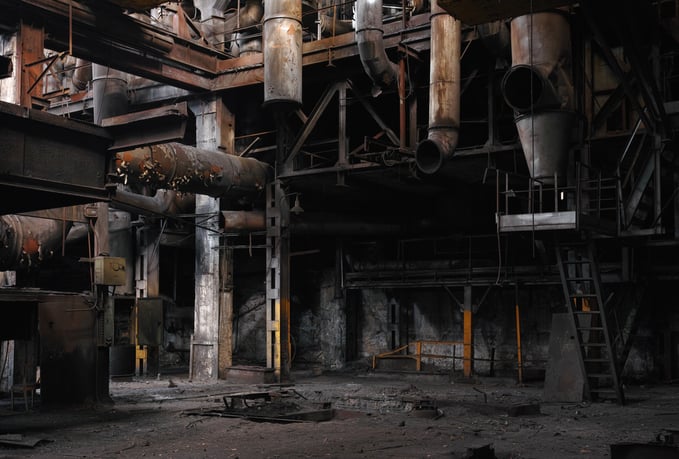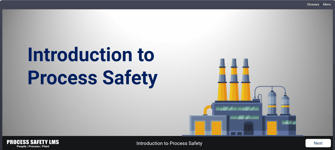Process Safety Blog
The Definition of Process Safety

The Definition of Process Safety
When most people think about workplace safety, they think about the general hazards that they are personally exposed to in the workplace, which usually fall under occupational health and safety rather than process safety.
These hazards are generally low in severity and occur often. They involve minor to moderate injuries to people that may require first aid treatment or hospitalisation but most likely do not lead to long-term disabilities. The impact of these hazards is localised and does not spread outside the boundaries of the workplace and into the general public. The solutions to reducing these health and safety risks are all about changing people’s behaviour.
It should be noted that occupational health and safety is about much more than minor injuries and is equally as important as process safety. However, this article is mainly focused on defining process safety, which is what Safety Solutions specialises in, rather than fully defining occupational health and safety.
Process safety is about protecting people from the types of hazards that are present in the process/manufacturing industries. These hazards are far more severe than occupational hazards and occur at a much lower frequency. They involve fatalities and/or severe and permanently disabling injuries to people. The impact of process safety hazards can spread outside the boundaries of the workplace and into the general public and they may also be related to a long-lasting environmental impact. The solutions to reducing risks related to processing safety are a blend of engineering and management skills aimed at eliminating or minimising risks to people and the environment due to the severe hazards that are present in the process/manufacturing industries.
Ad: Process Safety E-Learning (IChemE Approved) From $97 USD
Some examples of occupational and process safety hazards are listed below:
Occupational Health and Safety Process Safety
Acute Risks (fall & vehicle impact) Catastrophic Risks (fire, explosion, toxic release)
Chronic risks (long-term health issues) Severe Environmental Release
Slips, trips, and falls
Exposure to noise
Minor burns and cuts
Repetitive Strain Injuries
Process safety hazards are controlled either by elimination of the hazard by engineering design or by providing adequate protection layers (safeguards) to minimise the risk associated with the hazard. These protection layers can be achieved either by engineering design (preferred) and/or by administrative controls or procedures.
Examples of both engineering and administrative protection layers are listed below.
Engineering Administrative
Process control systems Critical operating procedures
Alarms Permit to work procedures
Equipment trips/shutdowns Emergency response plan
Mechanical overpressure protection Competency
Fire and gas detection systems Management of Change (MoC)
Fire protection systems
Bunds and Blast walls
Process safety has developed and advanced over the last 50 years in response to several severe industrial accidents that have occurred because of spectacular failures in process safety systems and lacklustre safety culture.
A summary of some of the more well-known industrial accidents is below.
Flixborough Disaster (1974)
The Flixborough disaster was an explosion that occurred at a chemical plant near the village of Flixborough in North Lincolnshire, England in 1974. The explosion killed 28 people and seriously injured 36 people.
The explosion occurred because of a temporary plant modification in which a leaking reactor was removed and bypassed using a temporary pipe while the repairs to the reactor were made. The temporary bypass did not go through any design review or MoC process and it subsequently failed. This resulted in a massive release of hot cyclohexane which led directly to an explosion. The effects of the explosion spread beyond the limits of the plant with 50 injuries to members of the general public and 2000 properties damaged.
You can see more about the Flixborough disaster by watching the following video.
Piper Alpha Disaster (1988)
The Piper Alpha disaster was a fire and series of explosions that occurred on the Piper Alpha oil platform in the North Sea about 120 miles northeast of Aberdeen, Scotland in 1988. The disaster killed 167 people.
The initial explosion was caused when operators started a condensate pump that had unbeknown to them had a vital piece of equipment (pressure safety valve) removed for routine maintenance during a previous shift. This resulted in a condensate (hydrocarbon) leak which ignited and caused a relatively small explosion. That should have been the end of the event, were it not for the lack of blast walls. The event escalated with the explosion rupturing crude oil pipes in a neighbouring module, leading to an oil fire. The ruptured pipes meant that operators were unable to isolate the platform and neighbouring platforms did not shut down. Oil continued to flow through the ruptured pipes which fuelled the fire. This eventually weakened two high-pressure gas lines from neighbouring platforms which ruptured leading to massive explosions. The platform eventually weakened and collapsed into the sea with 167 lives lost.
You can learn more about the Piper Alpha disaster by watching the following video which includes a detailed account of the sequence of events and a re-enactment of the disaster.
Texas City Refinery Disaster
The Texas City Refinery Disaster was a vapour cloud explosion that occurred at BPs Texas City Refinery in 2005. The disaster killed 15 people and injured 180 people.
The explosion occurred during the start-up of the isomerisation unit after a shutdown for maintenance activities.
During the start-up, of a raffinate tower with liquid hydrocarbons, many failures occurred with procedures, poor shift handover, poor locations of instruments leading to a lack of clear indication of plant state and failures of protection systems. The liquid eventually filled the tower completely and flooded a relief system designed to handle vapour, not liquid. Leading to a geyser of the flammable liquid ejecting from the top of the blowdown drum stack. This formed a rapidly expanding vapour cloud which ignited and sent an explosion through the refinery and temporary offices full of contract workers were right in the path of the explosion.
You can learn more about the Texas City Refinery disaster by watching the following video which includes a detailed account of the sequence of events and a re-enactment of the disaster.
Pike River Mine Disaster
The Pike River Mine Disaster was a coal mining accident caused by a series of explosions that occurred 46km northeast of Greymouth, New Zealand in 2010. The disaster killed 29 people. An additional 2 miners who were in the access tunnel at the time of the initial explosion managed to escape and were treated for moderate injuries.
The initial explosion is believed to have been caused by an accumulation of methane inside the mine. It is not known what sparked the explosion but a working mine contains several possible ignition sources. It is believed that all the 29 miners that died, were killed in the initial explosion.
A second explosion occurred 5 days after the initial explosion. The second explosion was not caused by anybody working in or around the mine.
A third smaller explosion occurred 7 days after the initial explosion.
A fourth explosion ignited the coal in the mine and the resulting fire was visible above the ventilation shaft. The fire complicated efforts to stabilise the mine and made recovery of any bodies unlikely.
A significant contributing factor to the disaster was a lack of safety measures common in Australia but not legally required in New Zealand. These safety measures included a “tube bundle” gas monitoring system, stocks of food and water, breathing apparatus and a second escape route.
A former mine supervisor alleged that miners continued to work when the methane concentrations were too high and that miners routinely blew compressed air over the methane alarms to prevent them from triggering.
As of 2021 Pike River Mine has remained sealed since the disaster because it is too dangerous to enter and no bodies have been recovered.
Fukushima Nuclear Disaster
The Fukushima Nuclear Disaster was a nuclear meltdown that occurred as a direct result of the Tōhoku earthquake and tsunami in 2011. The disaster resulted in the evacuation of 154,000 people.
The reactors shut down when the earthquake was detected. Electricity supply was lost to the reactors and the emergency diesel generators started. These are required to provide critical power to the cooling water pumps, which circulate coolant through the reactor cores to remove residual decay heat. However, the earthquake was followed by a tsunami which swept over the plant’s seawall and flooded the lower parts of the reactors. The flooding caused the failure of the emergency diesel generators and the loss of power to the circulating pumps. The resultant loss of cooling to the reactor cores led to a nuclear meltdown in the reactor and the widespread release of radioactive contamination over a wide area.
You can learn more about the Fukushima nuclear disaster by watching the following video which includes an account of the sequence of events that led to the disaster.
Many other significant process safety incidents have occurred around the world including, Bhopal, India (Toxic release), Buncefield, UK (fuel storage explosion), and Longford, Australia (Gas plant explosion). Many of these have had the effect of influencing legislation and the process safety industry.
